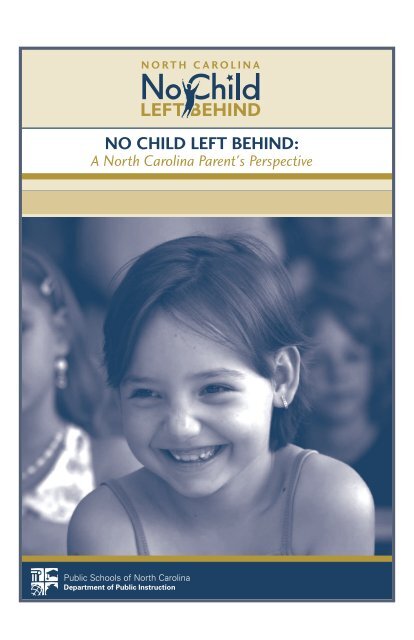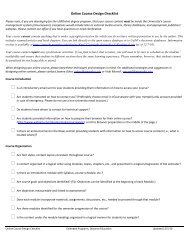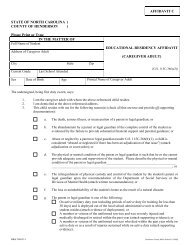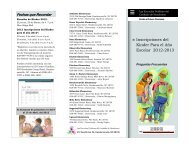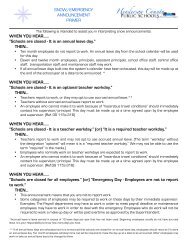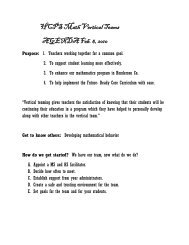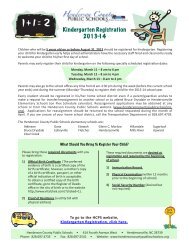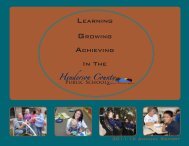NO CHILD LEFT BEHIND: - Henderson County Public Schools
NO CHILD LEFT BEHIND: - Henderson County Public Schools
NO CHILD LEFT BEHIND: - Henderson County Public Schools
You also want an ePaper? Increase the reach of your titles
YUMPU automatically turns print PDFs into web optimized ePapers that Google loves.
<strong>NO</strong>RTH CAROLINA<br />
<strong>NO</strong> <strong>CHILD</strong> <strong>LEFT</strong> <strong>BEHIND</strong>:<br />
A North Carolina Parent's Perspective<br />
<strong>Public</strong> <strong>Schools</strong> of North Carolina<br />
Department of <strong>Public</strong> Instruction
The No Child Left Behind (NCLB) Act of 2001 renewed and renamed the<br />
Elementary and Secondary Education Act (ESEA) of 1965. NCLB made<br />
significant changes that impact every public elementary and secondary school<br />
in the country. The state’s ABCs of <strong>Public</strong> Education program, begun in 1996,<br />
focused on the same academic standard-setting and accountability initiatives<br />
found in the NCLB legislation. But many changes brought by NCLB are new for<br />
the state. Here’s a look at what’s new and what’s not.<br />
ACADEMIC STANDARDS<br />
NCLB required states to adopt academic standards for students, but North Carolina<br />
had already done so years before. Academic standards are public statements about<br />
what all students should know and be able to do. North Carolina's standards for the<br />
major academic subjects in each grade, known as the NC Standard Course of Study,<br />
are posted on the Web at www.ncpublicschools.org/curriculum/ncscos. Below is an<br />
example of fifth grade math goals. You can get a copy of the goals for your child’s<br />
grade level from your child’s school or by accessing the Web.<br />
COMPETENCY GOAL 2:<br />
The learner will recognize and use standard units<br />
of metric and customary measurement.<br />
Objectives<br />
2.01 Estimate the measure of an object in one system<br />
given the measure of that object in another system.<br />
2.02 Identify, estimate, and measure the angles of<br />
plane figures using appropriate tools.<br />
ASSESSMENTS<br />
NCLB established testing requirements so that parents, students and educators<br />
could find out if students were making progress toward meeting the academic<br />
standards. All schools must measure student achievement in reading/language arts<br />
and math in grades 3-8 each year and at least once during the high school years.<br />
Once again, this didn't really mean anything new for North Carolina. The ABCs<br />
established annual end-of-grade and end-of-course testing years before. Test results<br />
are reported in terms of Level IV, advanced; Level III, proficient; Level II, basic; and<br />
Level I, below basic.
So far in our look at NCLB, if might seem as if not much has changed in North<br />
Carolina. But that’s not so. <strong>Schools</strong>, districts and the state now report student<br />
achievement in a new way.<br />
PUBLIC REPORTING<br />
Under NCLB, schools must issue a "report card" for each school. North Carolina was<br />
already doing that, but NCLB required the information on the report card to be more<br />
detailed. Here is the kind of information you've always been able to access in NC's<br />
school report cards on the Web at www.ncreportcards.org/src/.<br />
Performance of Students in Each Grade on the ABCs End-of-Grade Tests<br />
Grade 3 Grade 4 Grade 5 Grade 6 OVERALL<br />
Reading Math Reading Math Reading Math Reading Math Reading Math<br />
Our School 83.1 73.2 81.2 63.5 89.9 62.9 N/A N/A 84.6 65.9<br />
# of Tests Taken 71 71 85 85 89 89 1 1 246 246<br />
District 77.5 69.0 80.9 64.1 84.7 61.0 79.4 63.0 81.9 64.2<br />
State 82.9 67.8 83.4 65.0 88.4 63.1 81.5 61.9 84.9 63.4<br />
NCLB requires much more reporting information on specific groups of students as<br />
you can see below. With this reporting, the academic achievement of students as a<br />
whole at a school can't mask the underachievement of certain groups of students,<br />
often called the “achievement gap.”<br />
Percentage of Students At or Above Level III (Grade Level)<br />
All Male Female White Black Hispanic Amer. Asian/ Multi- E.D. N.E.D. L.E.P. Migrant Students<br />
Indian Pacific Racial Students with<br />
Islander<br />
Disabilities<br />
Our School 84.6 82.9 86.3 88.1 74.3 72.7 N/A N/A 77.8 72.2 89.7 69.2 N/A 48.6<br />
District 81.9 78.7 85.2 87.8 74.3 69.7 81.8 90.1 86.0 71.9 89.8 59.3 52.9 47.3<br />
State 84.9 82.0 88.0 91.4 75.3 73.9 76.7 90.7 87.8 76.2 92.6 61.0 58.1 56.2<br />
• E.D. = Economically Disadvantaged Students<br />
• N.E.D. = Not Economically Disadvantaged Students<br />
• L.E.P. = Limited English Proficient Students<br />
Of course, parents are usually most interested in the achievement level of their child.<br />
Your school is required by law to keep you informed of your child's achievement level.
ADEQUATE YEARLY PROGRESS (AYP)<br />
Along with the new reporting system, came a new way of defining school, district and<br />
state success. NCLB's major goal is for all public school children to perform at grade<br />
level in reading and math by the end of the 2013-14 school year. NCLB's<br />
accountability requirements are designed to tell whether schools, districts, and states<br />
are making Adequate Yearly Progress (AYP) toward meeting that goal.<br />
You may hear that your school "made AYP" or "didn't make AYP." AYP is a calculation<br />
measuring the yearly progress toward achieving grade-level performance in math and<br />
reading for each student group in a school, district or state. If just one student group at<br />
a school does not meet a target goal, then the school does not make AYP for that year.<br />
You can find out if your school made AYP by asking the principal or by looking on the<br />
Web at http://ayp.ncpublicschools.org/ and selecting "school detail" under type of<br />
report or select your school's report at www.ncreportcards.org/src/, then select<br />
"High Student Performance" and scroll down until you see "Adequate Yearly Progress<br />
(AYP) Results."<br />
Another way you might find out your school's AYP status is if your school receives Title I<br />
funding. If so, and it doesn't make AYP in the same subject for two years in a row, then<br />
the school must send you a letter informing you of that fact and your options.<br />
NCLB has its greatest impact in Title I schools. About 45 percent of the schools in<br />
our state are Title I schools – hundreds of elementary schools, over a hundred<br />
middle schools and less than a dozen high schools in any given year. You can find<br />
out if your school is a Title I school by asking your principal or by going to<br />
www.ncpublicschools.org/nclb/titleI/schools/ for listings of Title I schools.<br />
HIGHLY QUALIFIED<br />
The Highly Qualified requirement found in NCLB applies to all teachers - in Title I<br />
and non-Title I public schools - who teach in core academic subject areas. Highly<br />
Qualified teachers are fully certified and/or licensed by the state; hold at least a<br />
bachelor's degree from a four-year institution; and demonstrate competence in each<br />
core academic subject area in which they teach.<br />
North Carolina's school report cards report Highly Qualified information about your<br />
school with district and state comparisons under the "Quality Teachers" tab.
Here’s one more way NCLB might affect you even if your child doesn’t attend a<br />
Title I school: District Improvement. You may have gotten a letter from your<br />
school district announcing that it is in Title I District Improvement. Even though<br />
less than half of North Carolina’s schools receive Title I funding, all of North<br />
Carolina’s school districts do. Like schools, if districts consistently don’t meet<br />
target goals, they go into Title I Improvement and face sanctions. Detailed<br />
district AYP reports are on the Web at http://ayp.ncpublicschools.org/nclb. A<br />
current listing of District Improvement districts can be accessed on the Web at<br />
www.ncpublicschools.org/docs/nclb/district/.<br />
If your child attends a Title I school, you may be interested in reading "No Child Left<br />
Behind: For parents of students enrolled in a Title I school" available on the Web at<br />
www.ncpublicschools.org/nclb/parents/ or by calling 919.807.3450 for a printed copy.
TERMS MENTIONED IN THIS PUBLICATION<br />
The ABCs of <strong>Public</strong> Education is North Carolina's major school reform effort<br />
focusing on local school accountability, an emphasis on student mastery of basic<br />
skills, and as much local board and local educator control as possible.<br />
Academic (achievement) standards are set by the North Carolina Standard Course<br />
of Study (NCSOS) outlining what all students should know and be able to do for<br />
each grade level and academic subject. It defines the minimum standards for school<br />
systems to follow and to communicate to the public. State accountability measures<br />
are derived from the state curriculum.<br />
Accountability is the system in which the state requires that schools and districts<br />
meet achievement standards for what students should know and learn at each grade<br />
level. Assessments and public reporting of assessment results are part of the<br />
accountability system of finding out and reporting if students are making progress<br />
toward meeting the achievement standards.<br />
Achievement gap refers to the differences in academic performance, as measured by<br />
test scores or graduation rates, between different groups of students. Under No<br />
Child Left Behind, these groups are based on racial or ethnic backgrounds, family<br />
income, student disability, or English language proficiency.<br />
Assessment is another word for test. The term assessment is sometimes used to<br />
encompass not only standard test administration, but state-designed alternate<br />
assessments by which some students with disabilities are measured.<br />
Core academic subjects are English, reading, language arts, math, science, foreign<br />
languages, civics and government, social studies, economics, arts, history, geography,<br />
and kindergarten through Grade 6 (K-6). Under NCLB, only teachers meeting Highly<br />
Qualified criteria can teach these subjects.<br />
District Improvement is the status a district enters by not meeting target goals in<br />
the same subject (reading/language arts or math) in each of three grade spans (3-5,<br />
6-8, and high school) for two years in a row. All school districts in North Carolina<br />
receive Title I funding and are subject to being placed in Title I District Improvement.<br />
A district in Title I District Improvement must inform parents of the district’s status,<br />
revise its local education plan, set aside 10 percent of its Title I allotment for<br />
professional development purposes, and can no longer be a direct provider of<br />
supplemental educational services.
Elementary and Secondary Education Act is the principal federal law affecting K-12<br />
education. When the ESEA of 1965 was reauthorized and amended in 2001, it was<br />
renamed the No Child Left Behind Act. The 2001 reauthorization represented<br />
significant changes from the 1994 reauthorization that affect all public elementary<br />
and secondary schools in the country. The law is up for reauthorization in 2007.<br />
Highly Qualified is an NCLB-defined teacher requirement which, in North Carolina,<br />
is a teacher who has obtained full state teacher certification or has passed the state<br />
teacher licensing examination and holds a license to teach in the state; holds a<br />
minimum of a bachelor's degree; and has demonstrated subject area competence.<br />
No Child Left Behind (NCLB) Act of 2001 is the most recent reauthorization of<br />
the Elementary and Secondary Authorization Act of 1965. The reauthorized law<br />
added strict new accountability changes and mandated that every child be taught by<br />
a Highly Qualified teacher. The law emphasizes standards for teachers and<br />
consequences for Title I schools that do not meet student achievement standards for<br />
two or more consecutive years. The law’s major goal is for every school to be at 100<br />
percent proficiency by 2013-14 as measured by state tests.<br />
North Carolina Standard Course of Study (NCSOS) provides a guideline of what<br />
all students should know and be able to do for each grade level and academic subject.<br />
It defines the minimum standards for school systems to follow and to communicate to<br />
the public. State accountability measures are derived from the state curriculum.<br />
Proficient/Proficiency are terms referring to student work that meets the<br />
achievement standard set by North Carolina for that grade level.<br />
Sanctions is the term often used to describe the consequences for Title I schools in<br />
various levels of Title I School Improvement. The more years a school does not meet<br />
its Adequate Yearly Progress target goals in the same subject (reading/language arts<br />
and/or math), the more severe sanctions become.<br />
School Improvement is the status a Title I school enters after not making Adequate<br />
Yearly Progress for two consecutive years in the same subject (reading/language arts<br />
or math). A Title I school exits Improvement after two consecutive years of making<br />
Adequate Yearly Progress in the subject that identified it for Improvement (reading/<br />
language arts and/or math). It is possible for a school to exit Improvement for one<br />
subject, while entering into or remaining in Improvement based on the other subject.<br />
Title I is the largest federal education funding program. It provides funding for high<br />
poverty schools to help students who are behind academically or at risk of falling behind.<br />
Many of NCLB’s requirements – Adequate Yearly Progress, Highly Qualified teacher<br />
standards, accountability, sanctions for schools designated for Improvement, achievement<br />
standards and assessments, annual state report cards, professional development and<br />
parent involvement – are outlined in Title I. Title I used to be called Chapter One.
WEB SITES<br />
NCLB in North Carolina: www.ncpublicschools.org/nclb/<br />
Your school’s performance:<br />
The ABCs of <strong>Public</strong> Education: http://abcs.ncpublicschools.org/abcs/<br />
NC School Report Card: www.ncreportcards.org/src/<br />
AYP status: http://ayp.ncpublicschools.org/<br />
North Carolina’s Standard Course of Study (the state’s curriculum):<br />
www.ncpublicschools.org/curriculum/ncscos<br />
North Carolina’s Testing Program: www.ncpublicschools.org/accountability/testing/<br />
Title I School Listings: www.ncpublicschools.org/nclb/titleI/schools/<br />
US Department of Education’s NCLB Web site: www.ed.gov/nclb/landing.jhtml<br />
CONTACTS<br />
NCLB Coordinator, Dr. Belinda Black, 919.807.3827, bblack@dpi.state.nc.us<br />
Director of Student Support Services, Dr. Lynn Warren, 919.807.3957,<br />
lwarren@dpi.state.nc.us<br />
Supplemental Educational Services Coordinator, Lisa Huber, 919.218.3476,<br />
lhuber@dpi.state.nc.us<br />
NCLB Communications, 919.807.3450<br />
NC DEPARTMENT OF PUBLIC INSTRUCTION<br />
June St. Clair Atkinson, Ed.D., State Superintendent :: 301 N. Wilmington Street :: Raleigh, NC 27601-2825<br />
In compliance with federal law, NC <strong>Public</strong> <strong>Schools</strong> administers all state-operated educational<br />
programs, employment activities and admissions without discrimination because of race, religion,<br />
national or ethnic origin, color, age, military service, disability, or gender, except where exemption is<br />
appropriate and allowed by law.<br />
Inquiries or complaints regarding discrimination issues should be directed to:<br />
Robert Logan :: Office of Leadership for Innovation and Transformation<br />
6301 Mail Service Center :: Raleigh, NC 27699-6301 :: Telephone 919-807-3200 :: Fax 919-807-4065


